Pricing Guides & Dictionary of Makers Marks for Antiques & Collectibles

A few examples of appraisal values for
M WASHINGTON
Search our price guide for your own treasures
-
 WASHINGTON (VIRGINIA) Lithograph
WASHINGTON (VIRGINIA) Lithograph with tint stone by M. Alophe after a drawing by New York painter S.F. Dubourjal. Dubourjal's work was in turn based upon a life painting by Gilbert Stuart. Printed by Cattier. Published by Goupil Vibert & Co. Paris and New York C.1860. Washington is depicted three-quarter length in uniform outside a campaign tent. His left hand rests on a fortification plan spread out on a boulder. To the rear is a sketchy rendering of a river with a small village beyond. 11 1/4 x 9 1/8 in. (image).
WASHINGTON (VIRGINIA) Lithograph
WASHINGTON (VIRGINIA) Lithograph with tint stone by M. Alophe after a drawing by New York painter S.F. Dubourjal. Dubourjal's work was in turn based upon a life painting by Gilbert Stuart. Printed by Cattier. Published by Goupil Vibert & Co. Paris and New York C.1860. Washington is depicted three-quarter length in uniform outside a campaign tent. His left hand rests on a fortification plan spread out on a boulder. To the rear is a sketchy rendering of a river with a small village beyond. 11 1/4 x 9 1/8 in. (image). -
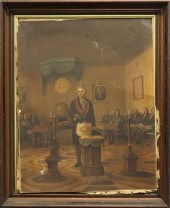 Chromolithograph of George
Chromolithograph of George Washington in Masonic attire, mounted in a walnut frame, as found, sight 26 1/2"h x 20"w
Chromolithograph of George
Chromolithograph of George Washington in Masonic attire, mounted in a walnut frame, as found, sight 26 1/2"h x 20"w -
 UNSIGNED PORTRAIT OF WASHINGTON,
UNSIGNED PORTRAIT OF WASHINGTON, WITH SADIK ATTRIBUTION TO GILBERT STUART Classic Bust Portrait, oil on canvas, with 2010 letter verso from Marvin Sadik, Director of the National Portrait Gallery at the Smithsonian in Washington, DC., stating this is by Stuart, who did in fact do many versions. In period lemon gold mitered frame with gesso edging, OS: 34 1/2' x 29 1/2", SS: 29" x 24", cleaned and relined, repairs to left edge, frame loss.
UNSIGNED PORTRAIT OF WASHINGTON,
UNSIGNED PORTRAIT OF WASHINGTON, WITH SADIK ATTRIBUTION TO GILBERT STUART Classic Bust Portrait, oil on canvas, with 2010 letter verso from Marvin Sadik, Director of the National Portrait Gallery at the Smithsonian in Washington, DC., stating this is by Stuart, who did in fact do many versions. In period lemon gold mitered frame with gesso edging, OS: 34 1/2' x 29 1/2", SS: 29" x 24", cleaned and relined, repairs to left edge, frame loss. -
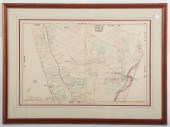 1877 MAP OF MT. WASHINGTON (DIST.
1877 MAP OF MT. WASHINGTON (DIST. 3, BALTIMORE), HAND COLORED ENGRAVING 16 1/2 x 25 1/4 in., framed.
1877 MAP OF MT. WASHINGTON (DIST.
1877 MAP OF MT. WASHINGTON (DIST. 3, BALTIMORE), HAND COLORED ENGRAVING 16 1/2 x 25 1/4 in., framed. -
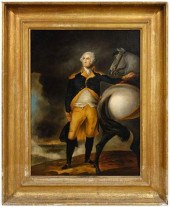 Washington after Gilbert Stuart,
Washington after Gilbert Stuart, George Washington at Dorchester Heights, circa 1830, after Gilbert Stuart, American, 1755-1828, oil on canvas, 39-1/2 x 29-1/2 in.; possibly original 19th century gilt wood cove molding frame. Lined with linen, retouch at repaired tears, draw crackle; frame retains some of original surface, tape accretion top of frame, abrasions. Estate of the Late William and Priscilla Carlebach, Mystic, Connecticut and Bedford, New York.
Washington after Gilbert Stuart,
Washington after Gilbert Stuart, George Washington at Dorchester Heights, circa 1830, after Gilbert Stuart, American, 1755-1828, oil on canvas, 39-1/2 x 29-1/2 in.; possibly original 19th century gilt wood cove molding frame. Lined with linen, retouch at repaired tears, draw crackle; frame retains some of original surface, tape accretion top of frame, abrasions. Estate of the Late William and Priscilla Carlebach, Mystic, Connecticut and Bedford, New York. -
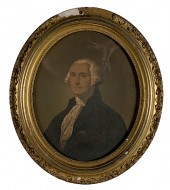 Middleton & Strobridge Litho on
Middleton & Strobridge Litho on Canvas of Washington a shoulder-length portrait of George Washington produced in 1861 by E.C. Middleton as indicated along the lower margin of the portrait and printed on verso; 13 x 16" framed 19.5 x 22". Condition: Moderate wear to print; significant chips in frame.
Middleton & Strobridge Litho on
Middleton & Strobridge Litho on Canvas of Washington a shoulder-length portrait of George Washington produced in 1861 by E.C. Middleton as indicated along the lower margin of the portrait and printed on verso; 13 x 16" framed 19.5 x 22". Condition: Moderate wear to print; significant chips in frame. -
 F. MASON HOLMES
F. MASON HOLMES (WASHINGTON/CONNECTICUT, 1865-1953F. MASON HOLMES (Washington/Connecticut, 1865-1953) oil on canvas, Mount Rainier. Signed lower left. Image measures 11" x 15.75". In a gilt wood frame; 16" x 20.5" overall.
F. MASON HOLMES
F. MASON HOLMES (WASHINGTON/CONNECTICUT, 1865-1953F. MASON HOLMES (Washington/Connecticut, 1865-1953) oil on canvas, Mount Rainier. Signed lower left. Image measures 11" x 15.75". In a gilt wood frame; 16" x 20.5" overall. -
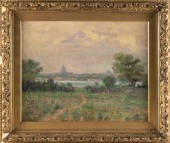 WELLS MOSES SAWYER (WASHINGTON,
WELLS MOSES SAWYER (WASHINGTON, D.C./FLORIDA/IOWA, 1863-1961), DISTANT VIEW OF THE CAPITOL., OIL ON CANVAS, 16” X 20”. FRAMED 22” X 26”.WELLS MOSES SAWYER, Washington, D.C./Florida/Iowa, 1863-1961, Distant view of the Capitol. Signed lower right "Wells M. Sawyer". Dimensions: Oil on canvas, 16" x 20". Framed 22" x 26".
WELLS MOSES SAWYER (WASHINGTON,
WELLS MOSES SAWYER (WASHINGTON, D.C./FLORIDA/IOWA, 1863-1961), DISTANT VIEW OF THE CAPITOL., OIL ON CANVAS, 16” X 20”. FRAMED 22” X 26”.WELLS MOSES SAWYER, Washington, D.C./Florida/Iowa, 1863-1961, Distant view of the Capitol. Signed lower right "Wells M. Sawyer". Dimensions: Oil on canvas, 16" x 20". Framed 22" x 26". -
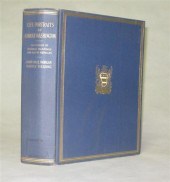 1 vol. (George Washington.)
1 vol. (George Washington.) Morgan, John Hill; Fielding, Mantle. The Life Portraits of Washington and Their Replicas. Philadelphia, (1931). 1/900 (of 1,000). 4to, orig. blue cloth, gilt, edges untrimmed; light edge wear. Color frontis., plain plates, tissue guards. Ex-library copy - label at foot of spine, ink stamp at foot of limitation page, plates & text leaves clean & unmarked.
1 vol. (George Washington.)
1 vol. (George Washington.) Morgan, John Hill; Fielding, Mantle. The Life Portraits of Washington and Their Replicas. Philadelphia, (1931). 1/900 (of 1,000). 4to, orig. blue cloth, gilt, edges untrimmed; light edge wear. Color frontis., plain plates, tissue guards. Ex-library copy - label at foot of spine, ink stamp at foot of limitation page, plates & text leaves clean & unmarked. -
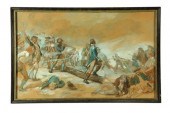 DEFENSE OF FORT WASHINGTON 1776 BY
DEFENSE OF FORT WASHINGTON 1776 BY JOHN WARD DUNSMORE (MICHIGAN/MASSACHUSETTS 1856-1945). Oil and graphite on paper unsigned. Large sketch of Washington leading battle. 28''h. 45''w. in a frame 31 1/2''h. 48''w.
DEFENSE OF FORT WASHINGTON 1776 BY
DEFENSE OF FORT WASHINGTON 1776 BY JOHN WARD DUNSMORE (MICHIGAN/MASSACHUSETTS 1856-1945). Oil and graphite on paper unsigned. Large sketch of Washington leading battle. 28''h. 45''w. in a frame 31 1/2''h. 48''w. -
 G. Washington lithograph by
G. Washington lithograph by Kellogg, "Washington", silhouette of George Washington with bald eagle, published 1844 by E. B. and E. C. Kellogg, page 17-1/8 x 12-3/8 in.; original 19th century bird-'s-eye maple ogee molding frame with gilt liner. Toning, light grime, masking tape all edges, five tears at edges, one with 3/8 x 1/2 in. loss to paper lower left edge, trimmed; frame with abrasions, losses to gilt surface. The Estate of Joel H. and Alice C. Radcliffe, Greensboro, North Carolina.
G. Washington lithograph by
G. Washington lithograph by Kellogg, "Washington", silhouette of George Washington with bald eagle, published 1844 by E. B. and E. C. Kellogg, page 17-1/8 x 12-3/8 in.; original 19th century bird-'s-eye maple ogee molding frame with gilt liner. Toning, light grime, masking tape all edges, five tears at edges, one with 3/8 x 1/2 in. loss to paper lower left edge, trimmed; frame with abrasions, losses to gilt surface. The Estate of Joel H. and Alice C. Radcliffe, Greensboro, North Carolina. -
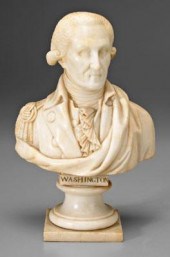 Washington bust after Wright,
Washington bust after Wright, George Washington wearing a figure eight epaulette on his proper right shoulder and draped on the other, 1790-1812, inscribed "Washington", attributed to the Ingram Studio, Volterra, Italy, finely hand-carved alabaster, early 19th century, 12 in. Restoration at fissure in wig, minor abrasions, pencil inscription. Estate of the Late William and Priscilla Carlebach, Mystic, Connecticut and Bedford, New York.
Washington bust after Wright,
Washington bust after Wright, George Washington wearing a figure eight epaulette on his proper right shoulder and draped on the other, 1790-1812, inscribed "Washington", attributed to the Ingram Studio, Volterra, Italy, finely hand-carved alabaster, early 19th century, 12 in. Restoration at fissure in wig, minor abrasions, pencil inscription. Estate of the Late William and Priscilla Carlebach, Mystic, Connecticut and Bedford, New York. -
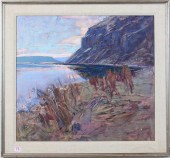 MICHAEL S. FERGUSON (WASHINGTON,
MICHAEL S. FERGUSON (WASHINGTON, 20TH CENTURY), AMICHAEL S. FERGUSON (Washington, 20th century), acrylic on board, "Columbia Raw." Signed lower left, titled verso, dated 1990. Image measures 21" x 23". In silvered wood frame; 25.5" x 27.5" overall.
MICHAEL S. FERGUSON (WASHINGTON,
MICHAEL S. FERGUSON (WASHINGTON, 20TH CENTURY), AMICHAEL S. FERGUSON (Washington, 20th century), acrylic on board, "Columbia Raw." Signed lower left, titled verso, dated 1990. Image measures 21" x 23". In silvered wood frame; 25.5" x 27.5" overall. -
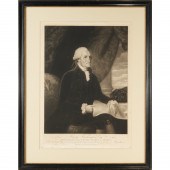 EDWARD SAVAGE, GEORGE WASHINGTON
EDWARD SAVAGE, GEORGE WASHINGTON PORTRAIT, 1793 "From the Original Portrait Painted at the request of the Corporation of the University of Cambridge in Massachusetts", mezzotint, shows Washington holding a map, matted and framed under plexiglass, gallery label and artist info verso, 21"h x 15"w (sheet), 28.25"h x 22.25"w (frame)
EDWARD SAVAGE, GEORGE WASHINGTON
EDWARD SAVAGE, GEORGE WASHINGTON PORTRAIT, 1793 "From the Original Portrait Painted at the request of the Corporation of the University of Cambridge in Massachusetts", mezzotint, shows Washington holding a map, matted and framed under plexiglass, gallery label and artist info verso, 21"h x 15"w (sheet), 28.25"h x 22.25"w (frame) -
 Three engravings after Gilbert
Three engravings after Gilbert Stuart: pair of George and Martha Washington within an oval, engraved by H. B. Halls Sons, New York, circa 1850, page 16-7/8 x 13-1/2 in., toning, foxing, laid down on mat board, abrasions, some staining ; "Washington" after Stuart's 1797 full portrait, 25-3/4 x 18 in., grime, tears, losses in margins, stains , all unframed. Private Collection.
Three engravings after Gilbert
Three engravings after Gilbert Stuart: pair of George and Martha Washington within an oval, engraved by H. B. Halls Sons, New York, circa 1850, page 16-7/8 x 13-1/2 in., toning, foxing, laid down on mat board, abrasions, some staining ; "Washington" after Stuart's 1797 full portrait, 25-3/4 x 18 in., grime, tears, losses in margins, stains , all unframed. Private Collection. -
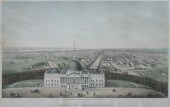 VIEW OF WASHINGTON. Lithograph by
VIEW OF WASHINGTON. Lithograph by Robert P. Smith. Framed - 18 1/4 in. x 28 1/2 in. sight size.
VIEW OF WASHINGTON. Lithograph by
VIEW OF WASHINGTON. Lithograph by Robert P. Smith. Framed - 18 1/4 in. x 28 1/2 in. sight size. -
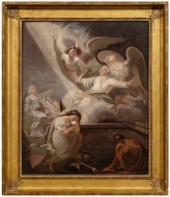 Washington painting after Barralet,
Washington painting after Barralet, "Commemoration of Washington" or "The Apotheosis of Washington", depiction of George Washington being lifted from his tomb by Time and Immortality and being mourned by Colombia (Freedom), a Native American, and the figures of Faith , Hope and Charity , after an 1802 engraving, by John James Barralet, Ireland/Philadelphia, Pennsylvania, 1747-1815, oil on canvas, American, 19th century, 27 x 22-1/4 in.; 20th century Empire style frame with anthemion at corners. Restretched on old stretcher, lined with wax and linen, minor retouch lower right and scattered in background and at edges, crackle, flaking, stretcher marks; frame with abrasions. Estate of the Late William and Priscilla Carlebach, Mystic, Connecticut and Bedford, New York.
Washington painting after Barralet,
Washington painting after Barralet, "Commemoration of Washington" or "The Apotheosis of Washington", depiction of George Washington being lifted from his tomb by Time and Immortality and being mourned by Colombia (Freedom), a Native American, and the figures of Faith , Hope and Charity , after an 1802 engraving, by John James Barralet, Ireland/Philadelphia, Pennsylvania, 1747-1815, oil on canvas, American, 19th century, 27 x 22-1/4 in.; 20th century Empire style frame with anthemion at corners. Restretched on old stretcher, lined with wax and linen, minor retouch lower right and scattered in background and at edges, crackle, flaking, stretcher marks; frame with abrasions. Estate of the Late William and Priscilla Carlebach, Mystic, Connecticut and Bedford, New York. -
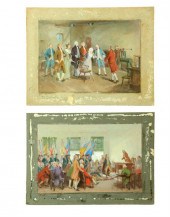 TWO INTERIOR VIEWS BY JOHN WARD
TWO INTERIOR VIEWS BY JOHN WARD DUNSMORE (MICHIGAN/MASSACHUSETTS 1856-1945). Oil on canvas. Studies of Washington and party inspecting the 1st silver coins struck in the US. Initialed and titled on the backing board. Splits. 13 1/2''h. 17 1/2''w. and Captured flags from Yorktown. Unsigned titled on the backing board. 16''h. 22''w. Both unframed glued to cardboard.
TWO INTERIOR VIEWS BY JOHN WARD
TWO INTERIOR VIEWS BY JOHN WARD DUNSMORE (MICHIGAN/MASSACHUSETTS 1856-1945). Oil on canvas. Studies of Washington and party inspecting the 1st silver coins struck in the US. Initialed and titled on the backing board. Splits. 13 1/2''h. 17 1/2''w. and Captured flags from Yorktown. Unsigned titled on the backing board. 16''h. 22''w. Both unframed glued to cardboard. -
 PLAN OF THE CITY OF WASHINGTON IN
PLAN OF THE CITY OF WASHINGTON IN THE TERRITORY OF COLUMBIA, CEDED BY THE STATES OF VIRGINIA AND MARYLAND, DATED 'MDCCC' (1800), FRAME: 26 X 32 IN. (66 X 81.3 CM.)Plan of the City of Washington in the Territory of Columbia, ceded by the States of Virginia and Maryland, Dated 'MDCCC' (1800),, Dimensions: Frame: 26 x 32 in. (66 x 81.3 cm.)
PLAN OF THE CITY OF WASHINGTON IN
PLAN OF THE CITY OF WASHINGTON IN THE TERRITORY OF COLUMBIA, CEDED BY THE STATES OF VIRGINIA AND MARYLAND, DATED 'MDCCC' (1800), FRAME: 26 X 32 IN. (66 X 81.3 CM.)Plan of the City of Washington in the Territory of Columbia, ceded by the States of Virginia and Maryland, Dated 'MDCCC' (1800),, Dimensions: Frame: 26 x 32 in. (66 x 81.3 cm.) -
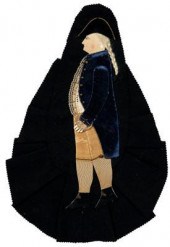 George Washington mourning
George Washington mourning epaulette, full-length cut-out profile portrait of Washington wearing a black velvet tricorn hat and blue velvet coat with lace fringe, paper face and hands with applied human hair (?) wig, white silk knickers and black boots, all applied to a wool epaulette, American, late 18th/early 19th century, 14 x 9-1/2 in. Small loss to paper surface near the ear, discoloration or stain to silk knickers. Estate of the Late William and Priscilla Carlebach, Mystic, Connecticut and Bedford, New York.
George Washington mourning
George Washington mourning epaulette, full-length cut-out profile portrait of Washington wearing a black velvet tricorn hat and blue velvet coat with lace fringe, paper face and hands with applied human hair (?) wig, white silk knickers and black boots, all applied to a wool epaulette, American, late 18th/early 19th century, 14 x 9-1/2 in. Small loss to paper surface near the ear, discoloration or stain to silk knickers. Estate of the Late William and Priscilla Carlebach, Mystic, Connecticut and Bedford, New York. -
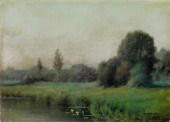 MARTHA MOFFETT BACHE (AMERICAN
MARTHA MOFFETT BACHE (AMERICAN 1893-1983) WASHINGTON OLD 7TH STREET WHARVES WITH THE MONUMENT IN THE BACK Oil on canvas board: 4 x 7 in. Framed; lower right signed: Martha Bache
MARTHA MOFFETT BACHE (AMERICAN
MARTHA MOFFETT BACHE (AMERICAN 1893-1983) WASHINGTON OLD 7TH STREET WHARVES WITH THE MONUMENT IN THE BACK Oil on canvas board: 4 x 7 in. Framed; lower right signed: Martha Bache -
 Earl Marshawn Washington
Earl Marshawn Washington (American b. 20th Century) "Weiner Werkstatte" and an untitled image of workman after woodcuts by other artists printed by Earl M.Washington and signed "Sc.E.M.W. 1917" and "Sc.E. M. Washington 1937" in lower left in pencil the factory worker image apprx. 8" x 11" paper size and the other apprx. 8-3/8" x 6-7/8" paper size. Not framed.
Earl Marshawn Washington
Earl Marshawn Washington (American b. 20th Century) "Weiner Werkstatte" and an untitled image of workman after woodcuts by other artists printed by Earl M.Washington and signed "Sc.E.M.W. 1917" and "Sc.E. M. Washington 1937" in lower left in pencil the factory worker image apprx. 8" x 11" paper size and the other apprx. 8-3/8" x 6-7/8" paper size. Not framed. -
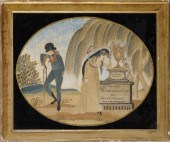 AMERICAN SILKWORK MOURNING PICTURE:
AMERICAN SILKWORK MOURNING PICTURE: ''IN MY LOSS EVER SHALL WE MOURN SACRED TO THE MEMORY OF THE ILLUSTRIOUS WASHINGTON'' Worked with two figures grieving at the memorial beneath a willow tree black eglomisé mat and giltwood frame. 17 x 21 1/2 in. (sight) 22 1/2 x 27 in. (frame).
AMERICAN SILKWORK MOURNING PICTURE:
AMERICAN SILKWORK MOURNING PICTURE: ''IN MY LOSS EVER SHALL WE MOURN SACRED TO THE MEMORY OF THE ILLUSTRIOUS WASHINGTON'' Worked with two figures grieving at the memorial beneath a willow tree black eglomisé mat and giltwood frame. 17 x 21 1/2 in. (sight) 22 1/2 x 27 in. (frame). -
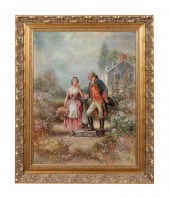 PERCY MORAN 'COURTSHIP OF G.
PERCY MORAN 'COURTSHIP OF G. WASHINGTON & MARTHA' Percy Moran (American, 1862-1935), 'The Courtship of George Washington and Martha Custis', 1922-1923, oil on canvas, depicting George Washington and Martha Custis standing together in a sumptuous garden with a home in the background, signed to lower left, titled, signed and dated en verso, framed. Approximate dimensions: canvas h. 24", w. 18"; frame h. 29.5", w. 23.625", d. 2.75"
PERCY MORAN 'COURTSHIP OF G.
PERCY MORAN 'COURTSHIP OF G. WASHINGTON & MARTHA' Percy Moran (American, 1862-1935), 'The Courtship of George Washington and Martha Custis', 1922-1923, oil on canvas, depicting George Washington and Martha Custis standing together in a sumptuous garden with a home in the background, signed to lower left, titled, signed and dated en verso, framed. Approximate dimensions: canvas h. 24", w. 18"; frame h. 29.5", w. 23.625", d. 2.75" -
 THREE FRAMED WATERCOLORS
THREE FRAMED WATERCOLORS Including an unsigned view on the Mall, Washington, D.C.
THREE FRAMED WATERCOLORS
THREE FRAMED WATERCOLORS Including an unsigned view on the Mall, Washington, D.C. -
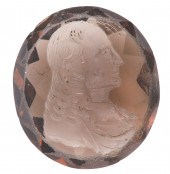 Carved Intaglio Portrait of
Carved Intaglio Portrait of Washington, a right facing carved profile portrait of George Washington, 1"H x 7/8"W, testing spinel, Provenance notes available from collector in London, can send upon request.
Carved Intaglio Portrait of
Carved Intaglio Portrait of Washington, a right facing carved profile portrait of George Washington, 1"H x 7/8"W, testing spinel, Provenance notes available from collector in London, can send upon request. -
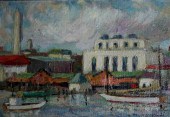 MARTHA MOFFETT BACHE (AMERICAN
MARTHA MOFFETT BACHE (AMERICAN 1893-1983) WASHINGTON OLD 7TH STREET WHARVES WITH THE MONUMENT IN THE BACK Oil on canvas board: 4 x 7 in. Framed; lower right signed: Martha Bache
MARTHA MOFFETT BACHE (AMERICAN
MARTHA MOFFETT BACHE (AMERICAN 1893-1983) WASHINGTON OLD 7TH STREET WHARVES WITH THE MONUMENT IN THE BACK Oil on canvas board: 4 x 7 in. Framed; lower right signed: Martha Bache -
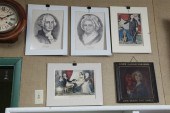 FOUR CURRIER & IVES PRINTS
FOUR CURRIER & IVES PRINTS PERTAINING TO GEORGE WASHINGTON. Two medium folios of George and Martha Washington. Small folio of ''Washington'' standing with an outstretched arm. And small folio ''Washington Family''. Matted.
FOUR CURRIER & IVES PRINTS
FOUR CURRIER & IVES PRINTS PERTAINING TO GEORGE WASHINGTON. Two medium folios of George and Martha Washington. Small folio of ''Washington'' standing with an outstretched arm. And small folio ''Washington Family''. Matted. -
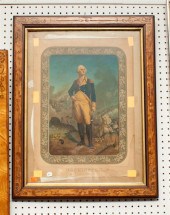 C. Schuessele; ''Washington'' (P.S.
C. Schuessele; ''Washington'' (P.S. Duval Philadelphia 1851) chromolithograph 21 3/4 x 15 3/4 in. framed Estimate $ 80-125
C. Schuessele; ''Washington'' (P.S.
C. Schuessele; ''Washington'' (P.S. Duval Philadelphia 1851) chromolithograph 21 3/4 x 15 3/4 in. framed Estimate $ 80-125 -
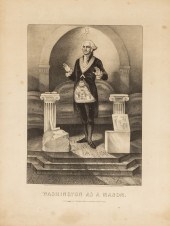 1868 CURRIER AND IVES "WASHINGTON
1868 CURRIER AND IVES "WASHINGTON AS A MASON" PRINT Bird's eye maple fame.
1868 CURRIER AND IVES "WASHINGTON
1868 CURRIER AND IVES "WASHINGTON AS A MASON" PRINT Bird's eye maple fame. -
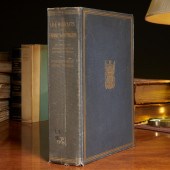 THE LIFE PORTRAITS OF WASHINGTON,
THE LIFE PORTRAITS OF WASHINGTON, 1931, INSCRIBED The Life Portraits of Washington and Their Replicas. John Hill Morgan and Mantle Fielding, Printed for the Subscribers, Philadelphia, from and edition of 1,000, 432 pages incl. index, color frontispiece, ex-Germantown Friends Free Library with gift inscription from the authors, hardcover, 12.5"h x 9.25"w
THE LIFE PORTRAITS OF WASHINGTON,
THE LIFE PORTRAITS OF WASHINGTON, 1931, INSCRIBED The Life Portraits of Washington and Their Replicas. John Hill Morgan and Mantle Fielding, Printed for the Subscribers, Philadelphia, from and edition of 1,000, 432 pages incl. index, color frontispiece, ex-Germantown Friends Free Library with gift inscription from the authors, hardcover, 12.5"h x 9.25"w -
 WASHINGTON COLOR SCHOOL STYLE MIXED
WASHINGTON COLOR SCHOOL STYLE MIXED MEDIA ASSEMBLAGE MOUNTED IN PLEXIGLASS VITRINE, SIGNED ILLEGIBLYWashington Color School Style Mixed Media Assemblage mounted in Plexiglass Vitrine, Signed Illegibly
WASHINGTON COLOR SCHOOL STYLE MIXED
WASHINGTON COLOR SCHOOL STYLE MIXED MEDIA ASSEMBLAGE MOUNTED IN PLEXIGLASS VITRINE, SIGNED ILLEGIBLYWashington Color School Style Mixed Media Assemblage mounted in Plexiglass Vitrine, Signed Illegibly -
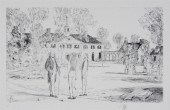 CHILDE FREDERICK HASSAM (AMERICAN
CHILDE FREDERICK HASSAM (AMERICAN 1859-1935) GEORGE WASHINGTON AT MOUNT VERNON Etching: 9 1/2 x 14 1/2 in. (sight) Framed; lower left signed and dated in plated: CH /1931; lower left numbered in graphite: 19; lower right signed and dated in plate: Childe Hassam / Nov 27th 1931; lower right signed in graphite: CH
CHILDE FREDERICK HASSAM (AMERICAN
CHILDE FREDERICK HASSAM (AMERICAN 1859-1935) GEORGE WASHINGTON AT MOUNT VERNON Etching: 9 1/2 x 14 1/2 in. (sight) Framed; lower left signed and dated in plated: CH /1931; lower left numbered in graphite: 19; lower right signed and dated in plate: Childe Hassam / Nov 27th 1931; lower right signed in graphite: CH -
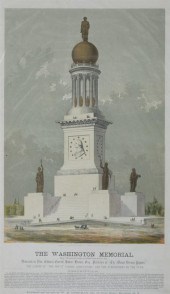 THE WASHINGTON MEMORIAL FROM A
THE WASHINGTON MEMORIAL FROM A MONUMENTAL DESIGN BY WILLIAM ROSS WALLACE ESQ. Engraved on wood and printed in colors by J.W. Orr New York. Published and for sale by W.G. Cordray Brooklyn N.Y. Unframed - 31 in. x 18 1/4 in. sheet size.
THE WASHINGTON MEMORIAL FROM A
THE WASHINGTON MEMORIAL FROM A MONUMENTAL DESIGN BY WILLIAM ROSS WALLACE ESQ. Engraved on wood and printed in colors by J.W. Orr New York. Published and for sale by W.G. Cordray Brooklyn N.Y. Unframed - 31 in. x 18 1/4 in. sheet size. -
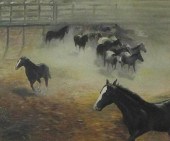 MARY KING (WASHINGTON, 20TH
MARY KING (WASHINGTON, 20TH CENTURY) OIL ON CANVASMARY KING (Washington, 20th century) oil on canvas, "Captured Colt." Signed lower left. Includes a short bio and gallery label. Image measures 20" x 24". In a wood frame; 28.5" x 32.5" overall.
MARY KING (WASHINGTON, 20TH
MARY KING (WASHINGTON, 20TH CENTURY) OIL ON CANVASMARY KING (Washington, 20th century) oil on canvas, "Captured Colt." Signed lower left. Includes a short bio and gallery label. Image measures 20" x 24". In a wood frame; 28.5" x 32.5" overall. -
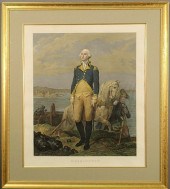 Framed and matted print of George
Framed and matted print of George Washington titled "Washington" the head after a Gilbert Stuart portrait. 28.5"x24.5"
Framed and matted print of George
Framed and matted print of George Washington titled "Washington" the head after a Gilbert Stuart portrait. 28.5"x24.5"
...many more examples with full details are available to our members - Learn more


